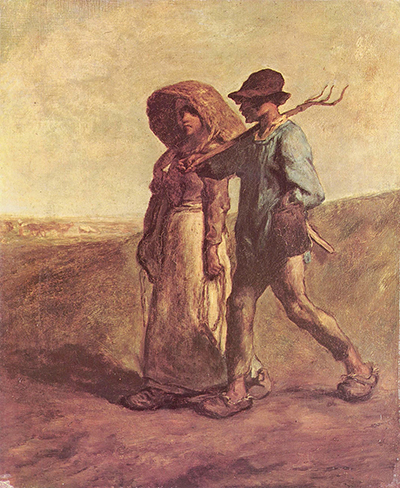The Gleaners
This particular artwork is an oil painting by Jean-Francois Millet called. Its completion was in 1857. The word gleaner in this particular piece symbolizes someone who picks grain left in a farm or field by harvesters. In the piece we observe a depiction of three poor women in the middle of the canvas bending focused on the ground picking grains of wheat. This painting brings out the culture that was practiced in the nineteenth century by the French which focused on harvest.
What made this particular painting famous was because it depicted how life was for the lowly ranked individuals in the society. This painting greatly aggravated the French upper classes. They attributed this displeasure to the fact that the painting seemed to glorify the lower class individuals.
Unlike other paintings the gleaners was large in size compared to other labor paintings. It was eighty four by one hundred and twelve centimeters which was a size mostly reserved in the painting of larger paintings of religion or mythological themes. The theme in the gleaner painting was one that shows the level of poverty and the classes of the workers.
This artwork is one of Millets most recognized pieces; this is because it clearly shows his stand as a critic in the contemporary social scene. He brings out the plight of the poor by depicting the three segregated peasant women in the painting.
Legacy
Through his different pieces of art Millets inspired different young artists like: Eugene Burnand who was born in 1824, Claude Monet born in 1840 and Pablo Picasso born in 1881who were all artists of their own time.
Vincent Van Gogh was greatly inspired by Millet during the onset of his painting. Millets work is mentioned severally in letters that were written to Vincent’s brother.
Theodore Rousseau was also greatly influenced by Millets realism in his artwork. During Millets hardest time Theodore purchased a painting from him but anonymously and pretended that a rich American had bought it in order to uplift Millets esteem.
Amazing articles about Millets work were written by Alexandre Dumas which attracted the attention of a wealthy art collector who agreed to pay him monthly for his work for three years.
Though fictional Millet inspires a play in which he is portrayed as a protagonist by Mark Twain. In the play Millet is depicted a young artist struggling and he eventually pretends to commit suicide in order to become famous.
Conclusion
The artwork of Jean-Francois Millet depicts the work of a true artist. Through his art the struggle of man and the world is depicted. He shows sympathy where there is cruelty; in the presence of mystery he is able to bring adoration. His work brings out the struggle of a man that is battling with his fate.




